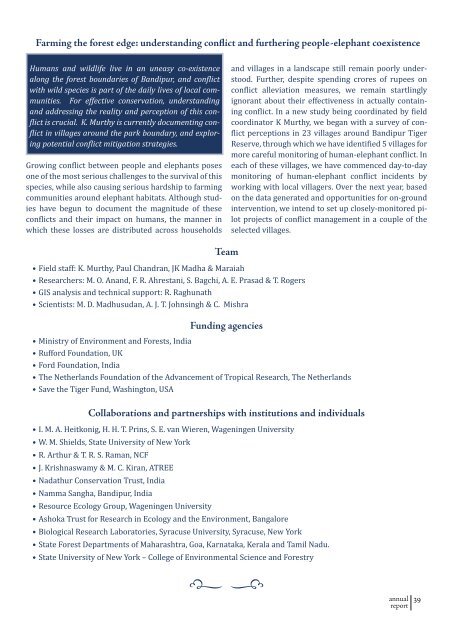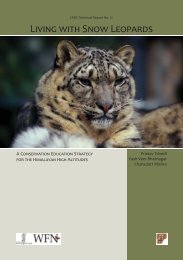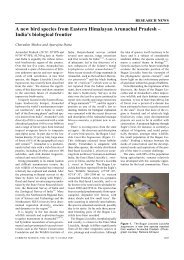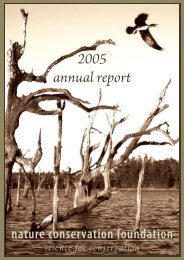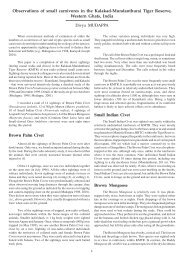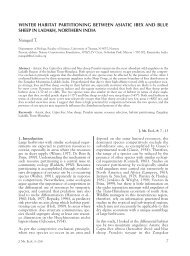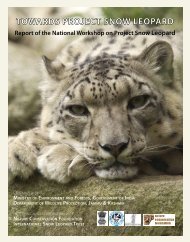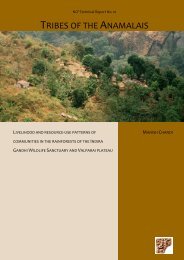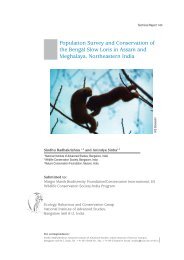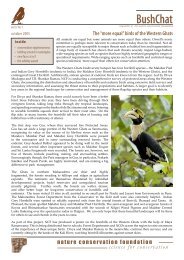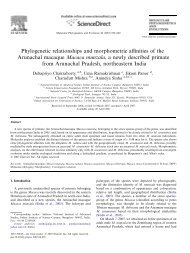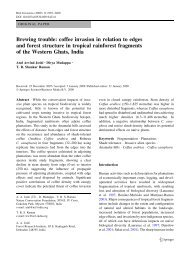2006-7 annual report - Nature Conservation Foundation
2006-7 annual report - Nature Conservation Foundation
2006-7 annual report - Nature Conservation Foundation
You also want an ePaper? Increase the reach of your titles
YUMPU automatically turns print PDFs into web optimized ePapers that Google loves.
Farming the forest edge: understanding conflict and furthering people-elephant coexistence<br />
Humans and wildlife live in an uneasy co-existence<br />
along the forest boundaries of Bandipur, and conflict<br />
with wild species is part of the daily lives of local communities.<br />
For effective conservation, understanding<br />
and addressing the reality and perception of this conflict<br />
is crucial. K. Murthy is currently documenting conflict<br />
in villages around the park boundary, and exploring<br />
potential conflict mitigation strategies.<br />
Growing conflict between people and elephants poses<br />
one of the most serious challenges to the survival of this<br />
species, while also causing serious hardship to farming<br />
communities around elephant habitats. Although studies<br />
have begun to document the magnitude of these<br />
conflicts and their impact on humans, the manner in<br />
which these losses are distributed across households<br />
and villages in a landscape still remain poorly understood.<br />
Further, despite spending crores of rupees on<br />
conflict alleviation measures, we remain startlingly<br />
ignorant about their effectiveness in actually containing<br />
conflict. In a new study being coordinated by field<br />
coordinator K Murthy, we began with a survey of conflict<br />
perceptions in 23 villages around Bandipur Tiger<br />
Reserve, through which we have identified 5 villages for<br />
more careful monitoring of human-elephant conflict. In<br />
each of these villages, we have commenced day-to-day<br />
monitoring of human-elephant conflict incidents by<br />
working with local villagers. Over the next year, based<br />
on the data generated and opportunities for on-ground<br />
intervention, we intend to set up closely-monitored pilot<br />
projects of conflict management in a couple of the<br />
selected villages.<br />
Team<br />
• Field staff: K. Murthy, Paul Chandran, JK Madha & Maraiah<br />
• Researchers: M. O. Anand, F. R. Ahrestani, S. Bagchi, A. E. Prasad & T. Rogers<br />
• GIS analysis and technical support: R. Raghunath<br />
• Scientists: M. D. Madhusudan, A. J. T. Johnsingh & C. Mishra<br />
Funding agencies<br />
• Ministry of Environment and Forests, India<br />
• Rufford <strong>Foundation</strong>, UK<br />
• Ford <strong>Foundation</strong>, India<br />
• The Netherlands <strong>Foundation</strong> of the Advancement of Tropical Research, The Netherlands<br />
• Save the Tiger Fund, Washington, USA<br />
Collaborations and partnerships with institutions and individuals<br />
• I. M. A. Heitkonig, H. H. T. Prins, S. E. van Wieren, Wageningen University<br />
• W. M. Shields, State University of New York<br />
• R. Arthur & T. R. S. Raman, NCF<br />
• J. Krishnaswamy & M. C. Kiran, ATREE<br />
• Nadathur <strong>Conservation</strong> Trust, India<br />
• Namma Sangha, Bandipur, India<br />
• Resource Ecology Group, Wageningen University<br />
• Ashoka Trust for Research in Ecology and the Environment, Bangalore<br />
• Biological Research Laboratories, Syracuse University, Syracuse, New York<br />
• State Forest Departments of Maharashtra, Goa, Karnataka, Kerala and Tamil Nadu.<br />
• State University of New York – College of Environmental Science and Forestry<br />
i j<br />
<strong>annual</strong><br />
<strong>report</strong><br />
39


